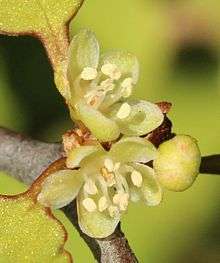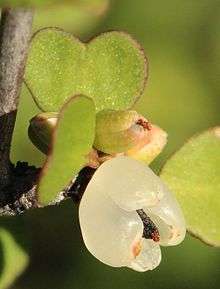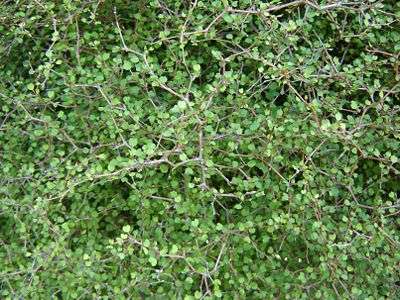Muehlenbeckia astonii
| Muehlenbeckia astonii | |
|---|---|
 | |
| Shrubby tororaro at Hackfalls Arboretum, Tiniroto, New Zealand | |
| Scientific classification | |
| Kingdom: | Plantae |
| (unranked): | Angiosperms |
| (unranked): | Eudicots |
| (unranked): | Core eudicots |
| Order: | Caryophyllales |
| Family: | Polygonaceae |
| Genus: | Muehlenbeckia |
| Species: | M. astonii |
| Binomial name | |
| Muehlenbeckia astonii Petrie | |
Muehlenbeckia astonii, common names shrubby tororaro and wiggy-wig bush, is an endemic New Zealand shrub, a distinctive ornamental plant in the Polygonaceae family. It is found only at the southern tip of the North Island (Palliser Bay) and on the eastern side of the South Island from northern Marlborough to Birdlings Flat at the south-west edge of Banks Peninsula, on the coast and on lowlands, especially terraced riverbeds.
It has very small heart-shaped leaves (only a few millimetres) that grow in clusters of two or three, or alternate along the longer branchlets, and is leafless in winter.
It has a great number of fine reddish brown to reddish orange branches that zigzag with one another to form a dense ball, up to 2–3 metres (6 ft 7 in–9 ft 10 in) round.
Flowers are tiny and grow in clusters of two to four, less than 10 millimetres (0.39 in) diameter, greenish to white or pinkish white.


The fruit, a dark three-angled nut, is about 3–4 millimetres (0.12–0.16 in) in diameter, surrounded by the remnants of the flower.
The English and Māori names are seldom used.
Its unusual form makes it an interesting garden plant, as a shelter plant in exposed situations or as an informal hedge. It needs dry conditions. It can easily be pruned to shape.
It is propagated by cuttings and seed.
Literature / sources
- Eadie, Fiona - 100 Best New Zealand Native Plants for Gardens. Random House, Auckland 2001. ISBN 1-86962-069-0
- Metcalf, L.J. - New Zealand Trees & Shrubs. A Comprehensive Guide to Cultivation and Identification. Reed Publishers, Auckland 1972-2000. ISBN 0-7900-0662-6
- Wilson, Hugh & Tim Galloway - Small-leaved Shrubs of New Zealand. Manuka Press, Christchurch 1993. ISBN 0-473-01851-9

External links
![]() Media related to Muehlenbeckia astonii at Wikimedia Commons
Media related to Muehlenbeckia astonii at Wikimedia Commons
- P. de Lange; C. Jones (2000). "Shrubby tororaro (Muehlenbeckia astonii Petrie) recovery plan 2000-2010" (PDF). Department of Conservation, Wellington, New Zealand. Retrieved 2007-04-18.
- Muehlenbeckia astonii
- Muehlenbeckia astonii photo
- the wiggy-wig bush - orphan or geriatric? by David R. Given
